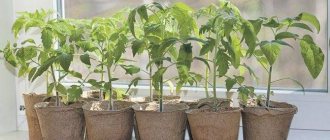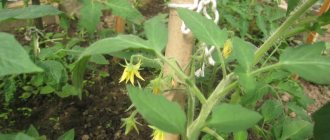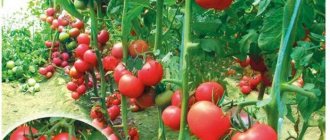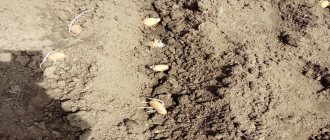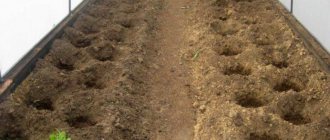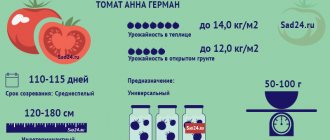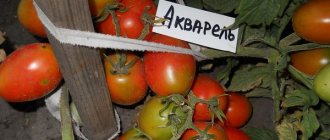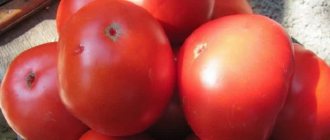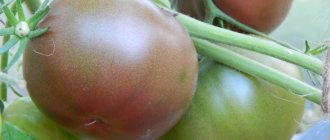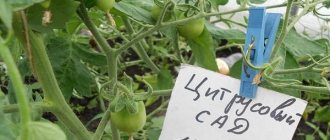Characteristics of the Bella Rosa tomato
With the arrival of spring, many people go to their dachas and garden plots to plant various vegetables, flowers and bushes. Every year, gardeners plant some new types of plants, and why not plant a special Bella Rossa tomato on your plot. This subspecies grows well in any climatic conditions and does not require close care.
Characteristics of the Bella Rosa tomato
The variety also has the name Bella Rosa f1 tomato. This letter denotes all hybrid species. This subspecies is perfectly rehabilitated in new conditions. Also, many gardeners noticed that it quickly takes root in a new place.
Description of the variety
The description says that the bush grows quite large, its maximum height is 1 m. The leaves have a pleasant green color. A tomato of this type should definitely be tied up and pinched. It is best to choose to grow a bush with two or three stems.
The Bella Rossa tomato fruit has a round shape and a pleasant red color. The weight of one tomato is approximately 150 g. The fruits are quite strong and fleshy, sweetish with a slight hint of bitterness. Bella Rosa tomato does not crack or wrinkle even if the fruit is overripe. That is why they are used for transportation, preservation in whole form and for making salads.
Advantages of Bella Rosa F1 tomato
- has excellent commercial qualities;
- bears fruit for a very long time;
- heat resistant;
- resistant to major diseases of melons.
It is this characteristic that most often attracts gardeners. After all, there are few subspecies that can boast of such taste and transport parameters.
Growing the variety
This tomato variety must be sown for at least 60 days. But, since the variety is a hybrid, the seed material and soil for planting require preparation.
Sowing seeds
Before sowing Bella Rosa tomato seeds for seedlings, you need to prepare the container and soil. The variety grows well in soil intended for planting indoor flowers. If such soil is not at hand, then you can use black soil with sand. Before planting, you should also prepare the seeds. It is recommended to soak them in potassium permanganate for 24 hours.
Such actions will remove any infection that may be inside or on the seed. After soaking, you can safely plant Bella Rosa tomatoes in the prepared container. To do this, make small holes in it, 2 cm deep. Then sprinkle with pre-prepared soil, water well and cover with a plastic bag. The variety remains in this state until the seeds germinate.
Seedling care
The plant needs good lighting
When the Bella Rosa F1 tomato seedlings produce two strong leaves, you need to pick. Each bush should be placed in a separate container. This will allow the seedlings to gain more strength and develop a powerful root system. For the development of bushes, seedlings must be provided with the right conditions.
The seedlings should be placed where there is sufficient light. If the day is not yet long enough, then additional lighting must be provided using a fluorescent lamp. The air temperature in the room should be above 15 degrees, otherwise all the seedlings will turn purple. Watering the plants should be done as the soil dries out; too much irrigation can lead to root rot, and a lack of moisture can lead to yellowing of the stem.
Planting seedlings
To transplant a variety into open ground, you need to choose the right place. It should be well lit and sufficiently fertilized. It is best to prepare a place for tomatoes in the fall. After you have decided where you will plant the seedlings, you need to make holes. The distance between them should be about 50 cm.
After this, you can safely replant the seedlings. To do this, fill the containers with seedlings well with water. Then carefully remove the seedlings and move them to open ground.
Tomato care
The Bella Rosa tomato fruit bush needs proper care. To do this, you must first water it properly. It is better to do this once a week, and on hot days twice every seven days. Do not overdo it with adding water to the soil, otherwise you can damage the root system of the subspecies.
It is also important to fertilize tomatoes. This can be done with a mixture of organic or inorganic preparations
A fertilizer such as superphosphate is perfect for tomatoes.
A fertilizer such as superphosphate is perfect for tomatoes.
Diseases and parasites Bella Rosa
The variety is resistant to various types of ailments that are characteristic of melons and nightshades. But prevention should still be carried out. This must be done with the help of special preparations that can be purchased at any gardening store.
Description of the variety
Bella Rosa tomato is included in the category of mid-season varieties. The bush belongs to the plants of the determinant type. The variety is high-yielding; more than 8 kg of fruit can be obtained from one plant.
The description says that the bush grows quite large, its maximum height is 1 m. The leaves have a pleasant green color. A tomato of this type should definitely be tied up and pinched. It is best to choose to grow a bush with two or three stems.
The Bella Rossa tomato fruit has a round shape and a pleasant red color. The weight of one tomato is approximately 150 g. The fruits are quite strong and fleshy, sweetish with a slight hint of bitterness. Bella Rosa tomato does not crack or wrinkle even if the fruit is overripe. That is why they are used for transportation, preservation in whole form and for making salads.
Advantages of Bella Rosa F1 tomato
- has excellent commercial qualities;
- bears fruit for a very long time;
- heat resistant;
- resistant to major diseases of melons.
It is this characteristic that most often attracts gardeners. After all, there are few subspecies that can boast of such taste and transport parameters.
Description and characteristics of the Bella Rosa F1 hybrid
Bella Rosa is a hybrid variety that produces a low-growing bush with long fruiting. A plant of a determinant type requires obligatory garter and periodic formation. The bush reaches a height of 70 cm. The variety is intended for cultivation in the Crimea, Kuban and Astrakhan region. The yield is up to 5 kg per 1 square meter. The fruits of this variety are round, slightly flattened and slightly ribbed. The weight of one tomato reaches 300 g. The pulp is dense, juicy, and has a sweetish taste. The skin is dense and does not crack during heat treatment. The harvest is intended for fresh consumption.
Advantages and disadvantages
Gardeners who have already grown the hybrid have noted the advantages and disadvantages of the plant. According to the manufacturer’s description, the tomato is endowed with the following positive characteristics:
- Early ripening.
- Long fruiting period.
- Good yield. With proper care, up to 7 kg of tomatoes can be harvested from 1 m² per season.
- The presented tomato is a first generation hybrid, which naturally indicates high viability.
- The fruits have a marketable appearance and tolerate transportation well.
- The plant is not susceptible to many of the diseases that affect tomatoes.
Attention! Due to the high dry matter content, the tomato is not suitable for juice extraction.
Planting seeds
Tomato is grown from seeds. To do this, buy fresh seeds, since their germination capacity may decrease every year. Planting material is sown in containers with prepared soil at the end of March
It is important that the soil is nutritious
After this, the seeds are sprinkled on top with dry sifted soil without lumps and moistened with clean warm water. It is better to do this with a spray bottle. You can use pastry or cake containers as a container.
Immediately after planting and moistening, the container is covered with glass or an ordinary transparent plastic bag in 1 layer and removed for germination in a warm place. However, the place should not be dark, as this will increase the germination time.
Harvesting and storage
Bella Rosa tomatoes are harvested every day at a temperature of +23. For fresh use, tomatoes are harvested at the stage of consumer ripeness. Such fruits are stored for no more than one week. You should not wait until the tomatoes are overripe, as their flesh becomes loose and the vegetables themselves lose their beneficial qualities. For canning and transportation, tomatoes are harvested during the technological stage of ripening. After harvesting, the specimens ripen within ten days. Conditions for storing the harvested crop:
Whole and healthy specimens are selected for storage; the tomatoes are dried and laid out in two layers in wooden boxes; the room temperature should not fall below 20 degrees, the humidity percentage should be at 80%; it is important that the room is well ventilated; For longer storage, tomatoes should be sprinkled with sawdust and left in a dark room at a temperature of 10 degrees.
If long-term storage is required, the fruits are harvested at the biological stage of maturity. The final harvest takes place before the first frost. It is recommended to remove diseased tomatoes along with high-quality tomatoes - this way the infection will not spread to the rest of the fruits.
Tomato Bella Rosa F1: variety description
This hybrid is classified as an early ripening hybrid - from the moment of germination of the seed to the harvesting of ripe Bella Rosa tomato products, about 110 days pass, and when grown by seedlings - less than two months after planting the seedlings in a permanent place.
The bushes of this tomato are of a determinate type, standard. The shoots can grow up to 0.7 m in height; they are well leafy and slightly pubescent. The foliage is medium-sized, slightly elongated, with sharp tips, slightly wrinkled, light emerald in color.
All buds are collected in inflorescences-tassels, each of which can produce up to 5 fruits.
On a note!
The shape of Bella Rosa tomatoes is round, slightly flattened at the base.
The skin is compacted, elastic, smooth, with a characteristic shine, not prone to cracking. The color of the skin and pulp is deep red. The pulp is tender, compacted, with several seed chambers (up to 7 pieces).
BEST TOMATOES! Tomato GIGALO Tomato Benito F1 Tomato Spasskaya Tower F1
The number of seeds is insignificant. Since the variety is a hybrid, it is not worth collecting your own seed material - the grown plants will not have positive parental characteristics.
Photo of Bella Rosa tomato on a bush
The size of the ripe Bella Rosa fruit machine is quite large, they are even, approximately the same, weighing about 250 g
. The amount of dry matter in the fruit is up to 6%, so the fruit is unsuitable for making juice or puree.
Due to the sufficient amount of sugars, ripe tomatoes of the Bella Rosa variety have a sweetish taste, with virtually no sourness. Due to the large size of the fruit and pleasant taste, this tomato variety is classified as a salad type.
The harvested crop can be transported to different distances, while the fruits do not crack and do not lose their wonderful taste. They can be stored under appropriate conditions for quite a long time.
Reviews
- Ekaterina from Krasnodar. I liked the tomato. The tomatoes are fleshy and very tasty, which is rare for hybrids. The bush itself is powerful, highly branched. There was not enough time for pinching and removing leaves, but the harvest did not disappoint.
- Svetlana from Belgorod. There is no way to call an early tomato. Maturation began in the middle period. The plant is really vigorous and well leafy, just as stated on the package. The bush requires timely garter and formation. I really liked the taste. The harvest was not so much - 4.9 kg per 1 m².
- Valentin from Tula. I tried to grow a hybrid in a greenhouse. I expected better. I planted the seedlings on the south side. The result was a low-growing plant with average fruits. I liked the taste, but was disappointed in the quantity. Perhaps a little experience in gardening and incorrect selection of varieties had an effect.
It is not difficult to grow a Bella Rosa tomato and collect many large, tasty fruits from the garden. The hybrid is unpretentious and will delight you with a harvest with minimal care.
Characteristics of the variety “Bella Rosa”
The plant is formed quite tall, intermediate type, erect. The leaves are large, closed, green in color. The wavy edges are weak. Flower corollas are medium sized, reddish-violet in color.
Root vegetables are oval-round or elongated in shape, covered with a slightly rough red skin. The weight of one root crop ranges from 118 to 210 g. The eyes are small. The pulp is light yellow, closer to beige, in color. Contains 15.7% starch. Potato marketability is from 82 to 99%. The keeping quality of the crop is 93%.
Rules for growing Bella Rosa tomatoes: planting seedlings and transplanting to a permanent place
Typically, this variety is grown by seedlings - in this case, it is possible to obtain harvests several weeks earlier than the period indicated in the description.
Sowing Bella Rosa tomato seeds for seedlings is carried out in March - a couple of months before transplanting the seedlings to a permanent place. Specific planting dates are calculated depending on weather conditions in the growing regions.
It is important to know!
Since the variety does not tolerate low temperatures and is not intended for cultivation in greenhouse conditions, Bella dew is not recommended for planting in regions with harsh climates.
Seed preparation
Seeds of this variety cannot be collected from bushes in the garden - the plants grown from them will not retain positive parental characteristics. Therefore, seed material must be purchased annually from specialized stores.
How to germinate tomato seeds
Such seeds undergo pre-sowing treatment in companies that sell them. Therefore, at home, they only soak tomato seed material in damp gauze for germination. Growth stimulants can be added to the water.
Preparation of nutrient substrate
Nutrient substrate for growing tomato seedlings is usually purchased in specialized stores. But you can cook it at home. To do this, in the fall, gardeners stock up on garden soil, humus or compost, coarse river sand and peat. In the spring, all these components are mixed, wood ash and sphagnum moss are added to make the soil loose.
INTERESTING! Iodine for tomatoes against late blight
Home-prepared soil mixture for seedlings should be disinfected before use. To do this, it is calcined in an oven heated to 180 degrees for 30 minutes.
Sowing tomato seeds for seedlings
The prepared substrate is laid out in containers, grooves no more than 1 cm deep are made in it. The distance between the grooves is about 2.5 cm. The seed material is laid out in the grooves at a distance of a couple of centimeters from each other. Then the ground is leveled and watered with a spray bottle.
The top of the container with Bella Rosa tomato seedlings is covered with polyethylene and transferred to a dark, warm room until the sprouts appear.
Typically, seed material begins to actively germinate 5-6 days after sowing.
Further care of Bella Rosa seedlings
After the shoots emerge, the polyethylene must be removed and the containers moved to a well-lit place. In the future, caring for Bella Rosa seedlings consists of regular watering and fertilizing.
Video about tomato seedlings
Tomatoes are watered as the soil dries with warm filtered water. If the water is cold, then such watering can provoke the development of blackleg or root rot in seedlings.
After the seedlings have a pair of permanent leaves, they should be picked into separate containers. 10-12 days after picking, the first fertilizing of Bella Rosa tomatoes is applied to the soil.
Usually urea or other fertilizers containing nitrogen are used for this.
. 12-14 days before transplanting plants to a permanent place, a second feeding should be done. Its composition does not differ from the first feeding.
On a note!
10-12 days before planting the seedlings in the beds, they are hardened off. To do this, the tomato plants are taken out onto the balcony or loggia for a short time at first, but gradually the time the plants stay outside increases.
Transplantation to a permanent place
The area for planting tomatoes is prepared in advance. Compost is added to the depleted soil before digging in the autumn - 7-8 kg for each square of area. In spring, 20 g of potassium salt and superphosphate are added to the planting holes.
When replanting, you need to remember that no more than 4 Bella Rosa tomato bushes should grow on each square of area.
Bella Rosa tomato seedlings are transplanted into open ground in mid-May, when it warms up well.
. The plants are transferred to the planting holes together with a lump of earth; if necessary, soil is added to the holes, compacted and watered. Then the root zone of the plants should be mulched.
How to grow
For successful cultivation of Bella Rosa, the manufacturer recommends following a number of rules:
- disinfection and germination of seeds before sowing;
- simultaneous stepsoning and gartering;
- removing side shoots 4-5 cm long until the first cluster appears;
- forming bushes in dry weather conditions to avoid fungal infection;
- moderate watering;
- compliance with the fertilizer application schedule (once every 3-4 days);
- prevention of bacterial diseases.
Sowing seeds
Seed material begins to be planted at the end of March or beginning of April, approximately 60 days before planting in open ground.
The seeds are disinfected in a pale pink solution of potassium permanganate for 30 minutes. Pre-germination helps to increase the percentage of germination. The seeds are laid out in one layer on one half of damp gauze, the other is covered and left for 2-3 days. The fabric is periodically moistened with warm water using a spray bottle.
For sowing, plastic containers, tetrapacks, and pots are used. Any soil for seedlings is suitable: from the garden or universal for growing flower plants. Drainage is poured into the bottom of the containers, then soil. Make furrows 1 cm deep and lay out the seeds at a distance of 2 cm. Cover with a thin layer of earth, water with a watering can and cover with plastic wrap.
Advice. It is recommended to pre-disinfect the soil from the garden in the oven.
Seedling care
Containers with future seedlings are placed in a shaded place, the film is removed from time to time for 10–15 minutes so that the soil does not become moldy. After the sprouts appear, the containers are taken to a well-lit place. If there is not enough sun, a phytolamp is additionally used. Moderate watering is necessary, the air temperature should not be lower than +15 ° C, otherwise the leaves will turn purple.
Planting into individual containers begins when the first true leaves appear. Peat cups are best suited; seedlings are planted directly into the ground in them.
Planting ready seedlings
The soil for planting seedlings begins to be prepared in the fall. The soil is dug up and weeds are removed along with their roots.
The transfer of seedlings is carried out in early May, making sure that the soil has warmed up sufficiently and the threat of frost has passed. The growing area must be sufficiently lit. Mullein is used as fertilizer. The holes are dug to a depth of 10–15 cm and filled with a solution of potassium permanganate. Planting density – 4 bushes per 1 m², distance – 50 cm.
Tomato care
Culture needs proper formation:
- The lateral stepsons located under the inflorescences are left.
- The main stem is pinched after the third leaf of the second inflorescence. Thus, the plant does not stretch in length, but grows in breadth and gains strength.
- As the plant grows, it is tied to a support so that the branches do not break under the weight of the fruit.
The best way to simplify plant care is to mulch the soil with sawdust, hay or pine needles. This slows down moisture evaporation and weed growth.
Tomatoes are watered as the soil dries - once every 7 days. During drought, the frequency of watering is increased to 3 times a week. Bella Rosa does not tolerate excess moisture well: the roots begin to rot, and the tomatoes become watery and sour.
Before flowering begins, apply mineral fertilizer. Experienced farmers advise using superphosphate for this purpose. You should not get carried away with potash fertilizers because of their ability to increase the level of chlorine in the soil, which negatively affects the taste of the fruit.
Next they switch to organic fertilizers (once every 3-4 days):
- compost;
- nettle infusion;
- wood ash;
- bird droppings.
To stimulate the growth and ovary of fruits, the following preparations are used: “Bud”, “Senior Tomato”, “Ovary”.
Advice. Apply watering and fertilizing exclusively to the root of the plant to prevent late blight infection.
Varieties for pickling
This category includes varieties with small fruits that have a dense skin that protects them from cracking during heat treatment. Pickling non-sapling tomatoes are distinguished by uniform yield. The average weight of each tomato is no more than 100 g. This allows the whole fruit to be placed in jars.
- Salting miracle. The compact bush (70-80 cm) does not need to remove stepsons. Fleshy, oval-shaped fruits ripen on clusters of 10-12 pieces. The harvest ripens after 3 months. Ripe tomatoes with thick skin can withstand transportation without loss. The pickling miracle is characterized by high immunity to disease and is resistant to temperature fluctuations. Smooth, plum-like fruits grow weighing up to 100 g.
- Lady fingers. A cylindrical shaped variety of non-grafting tomato. Rapid fruit ripening helps avoid late blight. Bushes 60 cm high are strewn with tomatoes, collected in brushes of 5-6 pieces. The pulp is tasty with a small number of seeds. It is grown mainly in open ground.
- Barnaul canning. An early variety resistant to low temperatures. Ripening occurs in 95-105 days. Round, orange-red cocktail-type tomatoes do not exceed 50 g in weight. The spreading bush requires tying up, otherwise the fruits will lean towards the ground. According to gardeners, the variety is ideal for home harvesting.
- Pepper. A very productive and undemanding variety, the fruits of which are intended for whole-fruit pickling. It is grown without support in open beds in the conditions of the middle zone, Siberia and the Urals. Smooth, elongated tomatoes with a miniature nose ripen in 3-3.5 months. The pulp and peel are bright red.
- Pickle. The determinate variety is recommended for open ground. Even in unfavorable weather conditions, the bush bears a large number of fruits. Hands loaded with ripening tomatoes require timely garter. Smooth, round tomatoes grow up to 70 g. The ripe pulp is red in color and has a pleasant taste.
Pickling varieties of tomatoes without pinching, as a rule, are distinguished by keeping quality. The thick skin facilitates long-term storage without loss of presentation.
Features of agricultural technology
It is not difficult to grow the presented hybrid on your own plot. The variety is not capricious and always brings a good harvest. The variety is intended for cultivation in open ground, but only in warm areas. The tomato does not tolerate cold well, but is resistant to heat. When grown in greenhouses and greenhouses, the stems are often elongated and weak.
Basic plant care includes watering and fertilizing. The tomato belongs to the standard determinate varieties, and therefore does not require the formation of a stem. The only thing that is required is the removal of old leaves in case of severe thickening.
Although the variety is endowed with resistance to common pathogens, disease prevention is periodically carried out. At the slightest suspicion of damage, the stems and leaves are sprayed with a soap solution and sprinkled with ash.
How to fight diseases and insects
The Bella Rosa hybrid is protected at the genetic level from viral diseases, but is susceptible to bacterial damage, rot and insect attacks.
To combat slugs and spider mites, use a soap, garlic or mustard solution, and decoctions of thyme, sage and lavender to wipe the leaves. Ash mixed with hot pepper is scattered around the bushes.
To prevent late blight, use:
- a solution of copper sulfate before flowering begins (for 10 liters of water, 2 tablespoons of copper sulfate);
- "Fitosporin" (diluted according to instructions);
- “Trichopol” (1 tablet per 1 liter of water);
- iodine solution with milk (9 liters of water + 1 liter of milk + 15 drops of iodine);
- hay tincture (infused in 10 liters of water with 2 tablespoons of urea for 4 days).
If infection cannot be avoided, diseased leaves and fruits are removed and burned, and the instrument is disinfected.
Disease prevention measures:
- Maintain a distance between seedlings (at least 50 cm).
- Mulching the soil.
- Removing the lower leaves.
- Moderate watering.
Advantages and disadvantages
The main advantages of the Bella Rosa hybrid:
- high productivity;
- simultaneous ripening of tomatoes;
- resistance to viruses;
- long shelf life;
- drought resistance;
- pleasant taste.
Among the disadvantages are:
- the need to adhere to a systematic regime of watering and fertilizing;
- whole fruits are not suitable for preservation;
- tomatoes are rarely used for purees and juice due to the large amount of dry matter (5-6%);
- bushes need garter;
- does not tolerate cold and sudden temperature fluctuations;
- It is not advisable to grow in greenhouses, since the stems stretch strongly upward, and the fruits grow small and lose their taste;
- susceptibility to bacterial infections.
Advantages and disadvantages
Among the advantages, it should certainly be noted:
- early harvest;
- resistance to major diseases;
- quite good yield;
- high taste qualities of finished products.
Among the disadvantages, it can be noted that it is not suitable for cultivation in all regions; it is very heat-loving. Many gardeners note resistance to major diseases. There are no particular difficulties when growing. Resistant to lack of moisture and other stressful situations. The finished crop tolerates long-term storage and transportation very well.
Read more on our website all about agrotechnical techniques for growing tomatoes:
- Planting seedlings.
- Stepsonning.
- Mulching.
- Watering.
- Preparing soil in a greenhouse.
As mentioned above, the variety is responsive to fertilizing. The most commonly used fertilizers are:
- Organic fertilizers.
- Mineral.
- Yeast.
- Iodine.
- Hydrogen peroxide.
- Ammonia.
- Boric acid.
- Ash.
We bring to your attention useful information on the topic: how to plant tomatoes correctly? What soil is suitable for growing seedlings and adult plants in greenhouses? What types of soil are there? As well as growth stimulants, fungicides and insecticides for nightshades.
Characteristics of Bella Rosa tomato fruits
The Bella Rosa F1 tomato hybrid is distinguished by small fruits. One ripe tomato weighs up to 120 grams on average. Maximum weight – 250 g. Tomatoes are oval-flat in shape. There is a slight ribbing near the stalk. There are a large number of seed chambers inside the tomato. The skin is smooth and thin. The tomatoes themselves are a rich scarlet hue.
The main advantage of this variety is the shelf life of vegetables. Red tomatoes can be stored for more than 2 weeks. Green fruits collected in late August or early September can last until October.
The tomatoes themselves are sweet and juicy. Well suited for preparing fresh salads and eating whole. They can also be used for canning as a whole. During the salting process, they fit well into jars and do not crack.
Description of the hybrid tomato Bella Rosa and rules for growing in open ground
Tomato Bella Rosa F1 is one of the earliest varieties. This is a hybrid bred in Japan. After planting in the garden, the plant needs only 50 days to produce mature fruits. The tomato does not require special care. Reviews about the tomato are positive. The variety has many advantages that make it suitable for both experienced gardeners and beginners. Bella Rosa is popular in many countries around the world.
What is Bella Rosa F1 tomato?
Characteristics and description of the variety:
- Bella Rosa F1 is included in the State Register of the Russian Federation.
- It was bred for southern regions with hot climates.
- Grows best in open ground. Not suitable for greenhouses.
- He is not afraid of heat and moderate drought.
- The variety does not tolerate cold.
- A tomato can die from temperature changes.
- The plant is standard, determinate, that is, low-growing.
- Its height is 50-80 cm. The bush is decorative, fluffy, and has many light green leaves.
- Leaves are medium sized. The plant has an intermediate inflorescence.
- The tomato is immune to many diseases, such as gray leaf spot, fusarium, verticillium, etc.
The fruits have a round shape, slightly flattened. The color inside and outside is bright red. There are no green or yellow spots on the stalk. The skin is strong and elastic. Because of this, the fruits are minimally susceptible to cracking.
Tomatoes are large and smooth - 200-300 g each. The pulp is dense. Inside there are from 5 to 7 chambers with seeds. The approximate amount of dry matter is 5-6%. Because of this, tomatoes are rarely used for making tomato juice and puree.
The taste of tomatoes is sweet. This is more of a salad variety. It is used for fresh consumption, salads, and snacks. Due to their large size, the whole fruit is not canned. For preparations they are cut into small pieces.
Bella Rosa brings a good harvest. With feeding and proper care, 3-4 kg of selected tomatoes are harvested from 1 bush. The variety bears fruit for quite a long time. Plot owners can pick fresh fruits for several months. Tomatoes tolerate transportation without problems and are stored for a long time. The variety is often grown for commercial purposes.
Pros of tomato:
- good yield;
- not demanding in care;
- excellent presentation of the fruit;
- decent taste characteristics;
- long fruiting period;
- keeping quality;
- ability to grow in hot climates;
- early ripeness;
- immunity to diseases;
- tolerates transportation without problems.
Disadvantages of the variety:
- the variety is not protected from insect pests;
- does not tolerate cold and temperature changes;
- needs fertilizer;
- not suitable for preparing tomato juice due to the high dry matter content in the fruit.
How to grow tomatoes?
Seeds are planted in boxes with soil mixture in March - 60 days before the intended planting in the garden.
Before landing, they are checked for suitability. To do this, it is enough to conduct a visual inspection and remove all damaged seeds. Valid seeds are soaked in a weak solution of manganese and then washed. Plant 1-2 cm into the ground. The distance between the seeds is at least 2 cm. Water and cover with a bag for a greenhouse effect. This way the sprouts will appear faster.
After the first strong leaves appear on the seedlings, the seedlings are transplanted into separate boxes or cups. Next they put it on the windowsill, closer to the sun. Every day, the container with green shoots is turned so that the plants receive light evenly. Moderate watering is required.
https://youtube.com/watch?v=WosW2hZX6x0
Elongated bushes are planted in open ground in May, when the soil has warmed up sufficiently and frosts are no longer expected. Usually the Bela Rosa variety is planted 4 bushes per 1 m². The soil should be fertilized in the fall and cleared of roots and weeds.
The variety requires tying to a support. Step-sonning is necessary. Experienced summer residents get the best harvest by leaving several stems on the bush. Before the first cluster blooms, all unnecessary shoots should be removed. Once every few days the bushes need to be fed with organic fertilizers. It is not recommended to use fresh manure.
Bella Rosa does not need constant watering. It is enough to do this 3 times a week or a little more often. To avoid the appearance of late blight, liquid fertilizers and water are poured only to the very roots.
Tomato Bella Rossa: characteristics and description of the variety
The Bella Rossa tomato is an early variety. This tomato hybrid was developed in Japan. The variety was included in the State Register in 2010. The optimal regions of the Russian Federation for growing tomatoes are Astrakhan and Krasnodar regions, Crimea. Tomatoes do not require special care; reviews about them are extremely positive. This variety of tomato is used for growing by both experienced gardeners and beginners. The Bella Rossa tomato is popular all over the world.
Characteristics and description of the Bella Rossa tomato variety
A photo of Bella Rossa tomatoes is presented below; based on reviews of tomatoes, one can judge the popularity and productivity of this variety. Main characteristics of tomatoes:
- Bella Rossa is a hybrid variety of tomatoes bred in Japan;
- a distinctive characteristic is a high level of drought resistance;
- tomatoes are practically not susceptible to diseases;
- the ripening period varies from 80 to 95 days; in the case of planting seedlings, the harvest can be harvested after 50 days;
- ripe tomatoes have the shape of a circle;
- the pulp of tomatoes is colored red;
- on average, the weight of one fruit is 180–220 g;
- Tomatoes of this variety are universal, suitable for canning and eating fresh.
This variety of tomatoes is determinate, standard, the tomatoes are well-leafed, and during the growth process they need a garter, since the bush can break under the weight of the fruit.
Brief description and taste of the fruit
Ripe tomatoes have a round, slightly flattened shape. The peel and pulp are rich red. There are no green or yellow spots in the stalk area. The peel is quite strong and elastic, as a result of which the fruits are not subject to cracking during the ripening process.
The tomatoes are large and smooth, capable of weighing up to 300 g. The pulp is dense, the seed chambers can be from 5 to 7. Since the dry matter contains about 6%, Bella Rossa is not suitable for making juices and purees.
Tomatoes taste sweet, they are used for canning, and are also eaten fresh for salads and various snacks. To increase the yield of tomatoes, it is necessary to properly care for planting material and apply fertilizing in a timely manner. If necessary, tomatoes can be transported over long distances without losing their appearance or taste.
Pros and cons of the variety
The Bella Rossa tomato variety is popular all over the world and this is not surprising, because tomatoes have a large number of advantages:
- early ripening;
- high level of productivity;
- simultaneous ripening of fruits;
- high resistance to most diseases;
- long-term storage of tomatoes;
- resistance to high temperatures and drought;
- great taste.
It is worth considering that in addition to the advantages, tomatoes of this variety also have some disadvantages:
- Bella Rossa does not tolerate low temperatures and sudden temperature changes;
- Fertilizers and fertilizing are periodically required;
- it is necessary to observe the watering regime;
- it is impossible to use tomatoes for making purees and juices;
- during the growth process, Bella Rossa bushes need a garter;
- Despite the high resistance to diseases, pests can appear on tomatoes.
Before choosing a tomato variety for planting, it is recommended to first study all the pros and cons.
Rules for planting and care
Before planting seedlings in open ground, carefully select a location. The area should be well lit by sunlight. Preparatory work at the site for planting tomato bushes includes applying fertilizers and moistening the soil.
The depth of the hole should be at least 5 cm, the distance between the bushes from 50 cm. Before planting Bella Rossa tomatoes, they must first be watered abundantly, which will prevent damage to the root system.
Sowing seeds for seedlings
Before sowing seeds, it is recommended to pre-disinfect the planting material. For these purposes, it is necessary to prepare a weak solution based on potassium permanganate and place the seeds in it for 20–25 minutes.
You can increase the germination rate of Bella Rossa tomato seeds only if you first germinate them. The gauze needs to be soaked in water, the seeds should be placed on it in one layer and covered. In this state, the seeds should be left for 2-3 days in a warm place. It is necessary to ensure that the gauze does not dry out. After germination, you can begin planting.
Drainage is poured into the bottom of the container and only after that soil. Make small furrows, sow the seeds and water with a small amount of water.
Then the container is covered with film and placed in a dark, warm place. Since the earth can become moldy, after 24 hours you should remove the film for literally 10–20 minutes. After the first tomato sprouts appear, the container is exposed to the sun.
As soon as several leaves appear, begin picking. To do this, use small peat cups. They can be used to plant seedlings in open ground. The sprouts are buried only if they have become very elongated during the growth process.
Transplanting seedlings
Bella Rossa tomatoes are recommended to be planted in open ground at the end of May. Depending on weather conditions in a particular region, seedlings can be insulated.
Before planting seedlings in open ground, first apply a small amount of manure or mullein. Applying fertilizers will make the soil fertile, as a result of which the tomatoes will grow much better and bring a high yield. For planting, it is recommended to use sunny, open places.
Particular attention is paid to the watering process. For example, if it is too frequent, the fruits will grow watery and sour. It is recommended to water tomato bushes no more than 3 times a week. After watering, you can loosen the soil and remove weeds. For 1 sq. m of plot you can plant up to 4 tomato bushes of the Bella Rossa variety. The soil should be prepared in advance - in the fall, and it is recommended to apply fertilizers and remove weeds along with the root system.
Features of cultivation, planting and care
Sowing seeds for seedlings is carried out 60-65 days before the intended planting in the ground. Seedlings dive at the stage of 2 true leaves. When planting seedlings in a permanent place, it is recommended to place up to 6 plants per 1 sq.m of land.
Further care for tomatoes consists of timely watering, weed removal, pinching, fertilizing with complex mineral fertilizer and preventive measures to protect the crop from diseases and pests.
For other interesting varieties with photos, descriptions and reviews, see our Tomato Catalog alphabetically. Enjoy watching!
If you grew Bella Rosa tomatoes, please write whether you liked them or not. What was the yield and taste of the fruits like under your climatic conditions? How do you rate the disease resistance of this hybrid? If possible, attach a photo of the entire bush or individual fruits you grew. Thank you!
Your reviews of the Bella Rosa tomato, as well as additions to the description, will help many gardeners evaluate this hybrid more objectively and decide whether it is worth planting or not.
Diseases, pests and treatment
The Bella Rosa tomato variety is resistant to fusarium, cladosporiosis and verticillium. In addition, tomatoes are protected from nematode attacks. However, the crop still needs preventive measures to prevent the development of fungal diseases. For prevention, you should spray the bushes with a solution of copper sulfate before flowering. An effective remedy is the composition of milk with iodine solution. Moreover, the plant is not protected from attacks by slugs and spider mites. Methods for treating tomatoes from fungal infections:
- Black leg, septoria, rot and mold - fungicides Fundazol, Skor and Previkur.
- Alternaria - fungicides Ridomil Gold, Oxychom.
- Late blight – treatment with Gamair, Ordan.
Late blight of tomatoes
To eliminate harmful insects and parasites, it is recommended to use a soap solution with the addition of ash. The leaves are wiped with the prepared mixture daily until the pests are completely eliminated. In addition, the soil around each bush is sprinkled with red pepper, the smell of which repels insects. In particularly advanced cases, treatment with chemicals may be required: insecticides Profi, Karate.
